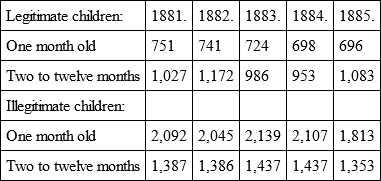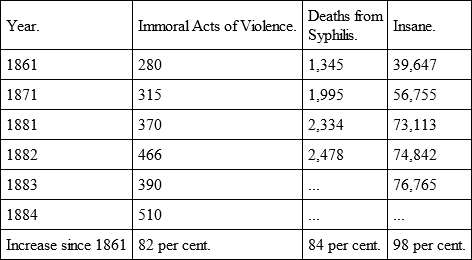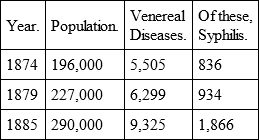 полная версия
полная версияWoman under socialism
Under such conditions, the traffic in female flesh has assumed mammoth proportions. It is conducted on a most extensive scale, and is most admirably organized in the very midst of the seats of civilization and culture, rarely attracting the notice of the police. A swarm of brokers, agents, carriers, male and female, ply the trade with the same unconcern as if they dealt in any other merchandise. Birth certificates are forged, and bills of lading are drawn up with accurate descriptions of the qualifications of the several "articles," and are handed over to the carriers as directions for the purchasers. As with all merchandise, the price depends upon the quality, and the several categories are assorted and consigned, according to the taste and the requirements of the customers in different places and countries. The slyest manipulations are resorted to in order to evade the snares and escape the vigilance of the police; not infrequently large sums are used to shut the eyes of the guardians of the law. A number of such cases have been established, especially in Paris.
Germany enjoys the sorry fame of being the woman market for half the world. The innate German migratory disposition seems to animate also a portion of the women. In larger numbers than those of any other people, the Austrian excepted, do they furnish their contingent to the supply of international prostitution. German women populate the harems of the Turks, as well as the public houses of central Siberia, and as far away as Bombay, Singapore, San Francisco and Chicago. In a book of travels,112 the author, W. Joest, speaks as follows on the German trade in girls: "People so often grow warm in our moral Germany over the slave trade that some African negro Prince may be carrying on, or over conditions in Cuba and Brazil, but they should rather keep in mind the beam in their own eyes: in no country is there such a trade with white female slaves, from no country is the export of this living merchandise as large as it is from Germany and Austria. The road that these girls take can be accurately followed. From Hamburg they are shipped to South America; Bahia and Rio de Janeiro receive their quotas; the largest part is destined for Montevideo and Buenos Ayres, while a small rest goes through the Straits of Magellan as far as Valparaiso. Another stream is steered via England, or direct to North America, where, however, it can hold its own only with difficulty against the domestic product, and, consequently, splits up down the Mississippi as far as New Orleans and Texas, or westward to California. Thence, the coast is supplied as far south as Panama; while Cuba, the West Indies and Mexico draw their supplies from New Orleans. Under the title of "Bohemians," further droves of German girls are exported over the Alps to Italy and thence further south to Alexandria, Suez, Bombay, Calcutta and Singapore, aye, even to Hongkong and as far as Shanghai. The Dutch Indies and Eastern Asia, Japan, especially, are poor markets, seeing that Holland does not allow white girls of this kind in its colonies, while in Japan the daughters of the soil are themselves too pretty and cheap. American competition from San Francisco also tends to spoil the otherwise favorable chances. Russia is provided from East Prussia, Pomerania and Poland. The first station is usually Riga. Here the dealers from St. Petersburg and Moscow supply themselves, and ship their goods in large quantities to Nischni-Novgorod and beyond the Ural Mountains to Irbit and Krestofsky, aye as far as the interior of Siberia. I found, for instance, a German girl in Tschita who had been traded in this way. This wonderful trade is thoroughly organized, it is attended to by agents and commercial travelers. If ever the Foreign Department of the German Empire were to demand of its consuls reports on this matter, quite interesting statistical tables could be put together."
This trade flourishes to this day at its fullest, as proved in the autumn of 1893 by a Social Democratic delegate to the German Reichstag.
The number of prostitutes is hard to estimate; accurately it can not be at all given. The police can state approximately the number of women whose principal occupation is prostitution; but it can not do this with regard to the much larger number of those who resort to it as a side means of income. All the same, the figures approximately known are frightfully high. According to v. Oettingen, the number of prostitutes in London was, as early as the close of the sixties, estimated at 80,000. In Paris the number of registered prostitutes in 1892 was 4,700, but fully one-third escape police control. In all Paris, there were, in 1892, about sixty brothels, with 600 to 700 prostitutes, and the number of brothels is steadily on the decline. On the other hand, based upon an investigation, instituted by the Municipal Council of Paris, in 1889, the number of women who prostitute themselves is placed at the enormous figure of 120,000. In Berlin, the number of prostitutes, registered with the police, was: —

In 1890, there were six physicians employed, whose duty it was to devote two hours a day to inspection.113 Since then the number of physicians has been increased. The prostitutes, registered with the police, constitute, however, in Berlin also, only a very small portion of the total. Expert sources estimate it at not less than 50,000. In the year 1890 alone, there were in 9,024 liquor saloons 2,022 bar-maids, almost all of whom yield to prostitution. Furthermore, the, from year to year, rising number of girls, arrested for disorderly conduct, shows that prostitution in Berlin is steadily on the increase. The numbers of these arrests were: —

Of the 16,605 girls, arrested in 1890, there were 9,162 carried for sentence before the Judge. There were, accordingly, 30 of these at every session of the court, and 128 of them were placed under the police by judicial decree. Already in 1860, it was calculated in Hamburg that every ninth woman was a prostitute. Since then the proportion has become greatly worse.
In Germany, the number of prostitutes probably runs up to 180,000. Accordingly, we here have to do with a large female army, that considers prostitution as a means of livelihood; and the number of victims, whom disease and death claim, is in proportion.114
Tait calculates for Edinburg that the average life of the prostitute is 22 to 25 years. According to him, year in and year out, every fourth aye, every third prostitute seeks to take her own life, and every twelfth actually succeeds in killing herself. A truly shocking state of things. The majority of prostitutes are heartily tired of their way of living; aye, that they are disgusted thereat, is an experience admitted by all experts. But once fallen into prostitution, only to very few is the opportunity ever offered to escape.
And yet the number of prostitutes increases in the same measure that does that of the women engaged as female labor in the various branches of industry and trade, and that are paid off with wages that are too high to die, and too low to live on. Prostitution is, furthermore, promoted by the industrial crises that have become a necessity of the capitalist world, that commence to become chronic, and that carry want and misery into hundreds and thousands of families. According to a letter of the Chief Constable of Bolton, October 31, 1865, to a Factory Inspector, the number of young prostitutes had increased more during the English cotton famine, consequent upon the North American war for the emancipation of the slaves, than during the previous twenty-five years.115 But it is not only the working-women, who, through want, fall a prey to prostitution. Prostitution also finds its recruiting grounds in the higher walks of life. Lombroso and Ferrero quote Mace,116 who says of Paris that "a governess certificate, whether of high or low degree, is not so much a draft upon bread, as upon suicide, theft and prostitution."
Parent-Duchatelet made out in his time a statistical table, according to which, out of 5,000 prostitutes there were 1,440 who took to the occupation out of want and misery; 1,250 were orphaned and without support; 80 prostituted themselves in order to feed poor parents; 1,400 were concubines left by their keepers; 400 were girls whom officers and soldiers had seduced and dragged to Paris; 280 had been deserted by their lovers during pregnancy. These figures speak for themselves. They need no further explanation. Mrs. Butler, the zealous champion of the poorest and most wretched of her sex in England, says on the subject of prostitution: "Fortuitous circumstances, the death of a father, of a mother, lack of work, insufficient wages, misery, false promises, snares, have led them to sin." Instructive also is the information given by K. Schneidt117 on the causes, that lead the Berlin bar-maids so often into the arms of prostitution. Shockingly large is the number of female servants that become barmaids, and that almost always means prostitutes. The answers that Schneidt received on his schedules of questions addressed to bar-maids, ran like this: "Because I got a child from my master and had to earn my living;" or "Because my book was spoiled;" or "Because with sewing shirts and the like too little is made;" or "Because I was discharged from the factory and could get no more work;" or "Because my father died, and there were four other little ones." That, particularly, servant girls, after they fall a prey to seduction by their masters, furnish a large contingent to the prostitutes, is a known fact. On the subject of the shockingly large number of seductions of servant girls by their masters or by the sons of these, Dr. Max Taude expresses himself reproachfully.118 When, however, the upper classes furnish their quota to prostitution, it is not want but seduction and the inclination for an easy life, for dress and for pleasures. On that subject a certain work119 utters itself this wise:
"Cold with horror and dismay, many a staid citizen, many a parson, teacher, high official, high military dignitary, etc., learns that his daughter has secretly taken to prostitution. Were it allowable to mention all these daughters by name, either a social revolution would take place on the spot, or the popular ideas concerning honor and virtue would be seriously damaged."
It is especially the finer prostitutes, the haute volee among the prostitutes, that are recruited from these circles. Likewise do a large portion of actresses, whose wardrobe outlays alone stand in crass disproportion to their salaries, depend upon such unclean sources of revenue.120 The same with numerous girls, engaged as sales-ladies, and in similar capacities. There are employers dishonorable enough to justify the low wages that they pay by referring their female employes to the aid of "friends." For instance: In 1889 the "Sachsische Arbeiter Zeitung" of Dresden published a notice that ran as follows: "A cultured young lady, long time out of work on account of lung troubles, looked, upon her recovery, for work of any sort. She was a governess. Nothing fit offered itself quickly, and she decided to accept the first job that came along, whatever it was. She first applied to Mr. – . Seeing she spoke readily several languages, she was acceptable; but the 30 marks a month wages seemed to her too small to get along with. She stated to Mr. – , and his answer was that most of his girls did not get even that much, but from 15 to 20 marks at most, and they all pulled through quite well, each having a 'good friend,' who helped along. Another gentleman, Mr. – , expressed himself in the same sense. Of course, the lady accepted a place in neither of the two establishments."
Seamstresses, female tailors, milliners, factory girls by the hundreds of thousands find themselves in similar plight. Employers and their subalterns – merchants, mill owners, landlords, etc., – who keep female hands and employes, frequently consider it a sort of privilege to find these women handy to administer to their lusts. Our pious and conservative folks love to represent the rural districts as truly idyllic in point of morality, compared with the large cities and industrial centers. Everyone acquainted with the actual state of things knows that it is not so; and the fact was evidenced by the address, delivered by a baronial landlord of Saxony in the fall of 1889, reported as follows in the papers of the place:
"Grimma. – Baron Dr. v. Waechter of Roecknitz, recently delivered an address, before a diocese meeting that took place here, upon the subject of 'Sexual Immorality in Our Rural Communities.' Local conditions were not presented by him in a rosy color. The speaker admitted with great candor that employers, even married ones, are frequently in very intimate relations with their female domestics, the consequences of which were either cancelled with cash, or were removed from the eyes of the world through a crime. The fact could, unfortunately, not be cloaked over, that immorality was nursed in these communities, not alone by girls, who, as nurses in cities, had taken in the poison, or by fellows, who made its acquaintance in the military service, but that, sad to say, also the cultured classes, through the stewards of manorial estates, and through the officers on the occasions of field manoeuvres, carried lax principles of morality into the country districts. According to Dr. v. Waechter, there are actually here in the country few girls who reach the age of seventeen without having fallen." The open-hearted speaker's love of truth was answered with a social boycott, placed upon him by the officers who felt insulted. The jus primae noctis of the medieval feudal lord continues in another form in these very days of ours.
The majority of prostitutes are thrown into the arms of this occupation at a time when they can hardly be said to have arrived at the age of discretion. Of 2,582 girls, arrested in Paris for the secret practice of prostitution, 1,500 were minors; of 607 others, 487 had been deflowered under the age of twenty. In September, 1894, a scandal of first rank took the stage in Buda-Pest. It appeared that about 400 girls of from twelve to fifteen years fell prey to a band of rich rakes. The sons of our "property and cultured classes" generally consider it an attribute of their rank to seduce the daughters of the people, whom they then leave in the lurch. Only too readily do the trustful daughters of the people, untutored in life and experience, and generally joyless and friendless, fall a prey to the seduction that approaches them in brilliant and seductive guise. Disillusion, then sorrows, finally crime, – such are the sequels. Of 1,846,171 live births in Germany in 1891, 172,456 were illegitimate. Only conjure up the volume of worry and heartaches prepared for a great number of these mothers, by the birth of their illegitimate children, even if allowance is made for the many instances when the children are legitimatized by their fathers! Suicide by women and infanticide are to a large extent traceable to the destitution and wretchedness in which the women are left when deserted. The trials for child murder cast a dark and instructive picture upon the canvas. To cite just one case, in the fall of 1894, a young girl, who, eight days after her delivery, had been turned out of the lying-in institute in Vienna and thrown upon the streets with her child and without means, and who, in her distress and desperation, killed the infant, was sentenced to be hanged by a jury of Krems in Lower Austria. About the scamp of a father nothing was said. And how often do not similar instances occur! The seduced and outrageously deserted woman, cast helpless into the abyss of despair and shame, resorts to extreme measures: she kills the fruit of her womb, is dragged before the tribunals, is sentenced to penitentiary or the gallows. The unconscionable, and actual murderer, – he goes off scott-free; marries, perchance, shortly after, the daughter of a "respectable and honest" family, and becomes a much honored, upright man. There is many a gentleman, floating about in honors and distinctions, who has soiled his honor and his conscience in this manner. Had women a word to say in legislation, much would be otherwise in this direction.
Most cruel of all, as already indicated, is the posture of French legislation, which forbids inquiry after the child's paternity, and, instead, sets up foundling asylums. The resolution on the subject, by the Convention of June 28, 1793, runs thus: "The nation takes charge of the physical and moral education of abandoned children. From that moment they will be designated only by the term of orphans. No other designation shall be allowed." Quite convenient for the men, who, thereby, shifted the obligation of the individual upon the collectivity, to the end of escaping exposure before the public and their wives. In all the provinces of the land, orphan and foundling asylums were set up. The number of orphans and foundlings ran up, in 1893, to 130,945, of which it was estimated that each tenth child was legitimate, but not wanted by its parents. But no particular care was taken of these children, and the mortality among them was, accordingly, great. In that year, fully 59 per cent., i. e., more than one-half died during the first year of their lives; 78 per cent. died twelve years of age and under. Accordingly, of every 100 only 22 reached the age of twelve years and over. It is claimed that matters have in the meantime improved in those establishments.
In Austria and Italy also foundling asylums were established, and their support assumed by the State. "Ici on fait mourir les enfants" (Here children are killed) is the inscription that a certain King is said to have recommended as fit for foundling asylums. In Austria, they are gradually disappearing; there are now only eight of them left; also the treatment and care of the children has considerably improved to what it was. In 1888, there were 40,865 children cared for in Austria, including Galicia; of these 10,466 were placed in public institutions, 30,399 under private care, at a joint cost of 1,817,372 florins. Mortality was slighter among the children in the public institutions than among those placed under private care. This was especially the case in Galicia. There, 31.25 per cent. of the children died during the year 1888 in the public establishments, by far more than in the public establishments of other countries; but of those under private care, 84.21 per cent. died, – a veritable mass-assassination. It almost looks as though the Polish slaughterhouse system aimed at killing off these poor little worms as swiftly as possible. It is a generally accepted fact that the percentage of deaths among children born out of wedlock is far higher than among those born in wedlock. In Prussia there died, early in the sixties, during the first year of their lives 18.23 per cent. of children born in wedlock, and 33.11 per cent. of children born out of wedlock, accordingly twice as many of the latter. In Paris there died, 100 children born in wedlock to every 139 born out of wedlock, and in the country districts 215. Italian statistics throw up this picture: Out of every 10,000 live-births, there died —

The difference in the mortality between legitimate and illegitimate children is especially noticeable during the first month of life. During that period, the mortality of children born out of wedlock is on an average three times as large as that of those born in wedlock. Improper attention during pregnancy, weak delivery and poor care afterwards, are the very simple causes. Likewise do maltreatment and the infamous practice and superstition of "making angels" increase the victims. The number of still-births is twice as large with illegitimate than with legitimate children, due, probably, mainly to the efforts of some of the mothers to bring on the death of the child during pregnancy. The illegitimate children who survive revenge themselves upon society for the wrong done them, by furnishing an extraordinary large percentage of criminals of all degrees.
Yet another evil, frequently met, must also be shortly touched upon. Excessive sexual indulgence is infinitely more harmful than too little. A body, misused by excess, will go to pieces, even without venereal diseases. Impotence, barrenness, spinal affections, insanity, at least intellectual weakness, and many other diseases, are the usual consequences. Temperance is as necessary in sexual intercourse as in eating and drinking, and all other human wants. But temperance seems difficult to youth. Hence the large number of "young old men," in the higher walks of life especially. The number of young and old roues is enormous, and they require special irritants, excess having deadened and surfeited them. Many, accordingly, lapse into the unnatural practices of Greek days. The crime against nature is to-day much more general than most of us dream of: upon that subject the secret archives of many a Police Bureau could publish frightful information. But not among men only, among women also have the unnatural practices of old Greece come up again with force. Lesbian love, or Sapphism, is said to be quite general among married women in Paris; according to Taxal,121 it is enormously in practice among the prominent ladies of that city. In Berlin, one-fourth of the prostitutes are said to practice "tribady;" but also in the circles of our leading dames there are not wanting disciples of Sappho. Still another unnatural gratification of the sexual instinct manifests itself in the violation of children, a practice that has increased greatly during the last thirty years. In France, during 1851-1875, 17,656 cases of this nature were tried. The colossal number of these crimes in France is intimately connected with the two-child system, and with the abstinence of husbands towards their wives. To the German population also we find people recommending Malthusianism, without stopping to think what the sequels will be. The so-called "liberal professions," to whom belong mainly the members of the upper classes, furnish in Germany about 5.6 per cent. of the ordinary criminals, but they furnish 13 per cent. of the criminals indicted for violation of children; and this latter percentage would be still higher were there not in those circles ample means to screen the criminals, so that, probably, the majority of cases remain undiscovered. The revelations made in the eighties by the "Pall Mall Gazette" on the violation of children in England, are still fresh in the public memory.
The moral progress of this our best of all possible worlds is recorded in the below tables for England, the "leading country in civilization." In England there were: —

A frightful increase this is of the phenomena that point to the rising physical and moral ruin of English society.
The best statistical record of venereal diseases and their increase is kept by Denmark, Copenhagen especially. Here venereal diseases, with special regard to syphilis, developed as follows: —

Among the personnel of the navy in Copenhagen, the number of venereal diseases increased 1224 per cent. during the period mentioned; in the army and for the same period, 227 per cent.122 And how stands it in Paris? From the year 1872 to the year 1888, the number of persons treated for venereal diseases in the hospitals Du Midi, de Lourcine and de St. Louis was 118,223, of which 60,438 suffered of syphilis and 57,795 of other venereal affections. Besides these, of the number of outside persons, who applied to the clinics of the said three hospitals, there was a yearly average of 16,385 venereals.123
We have seen how, as a result of our social conditions, vice, excesses, wrongs and crimes of all sorts are bred. All society is kept in a state of unrest. Under such a state of things woman is the chief sufferer.



